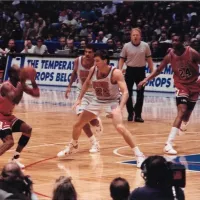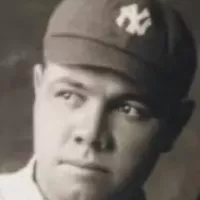The Topps Company is an American manufacturer of trading cards and collectibles, most notably known for its baseball and other sports-themed cards. The company also produces cards under the Allen & Ginter and Bowman brand names. Topps has a long history in the collectibles market and is a major player in the sports trading card industry.
1951: Cards for American Football
In 1951, Topps also produced cards for American football, which are known as the Magic set.
1952: Player Statistics on Cards
In 1952 Topps included one line for statistics from the most recent year (i.e. the 1951 season) and another with the player's lifetime totals.
1952: Topps Provided Player Statistics
Starting with the 1952 set, Topps began providing player statistics on their cards. This was a significant contribution to Topps's success, as complete baseball stats were not widely available at the time. Topps compiled the stats themselves from published box scores.
1954: Cards for Ice Hockey
In 1954, Topps made cards for ice hockey, featuring players from the four National Hockey League franchises located in the U.S. at the time: the Boston Bruins, Chicago Blackhawks, Detroit Red Wings, and New York Rangers.
1954: Two Pictures on the Front of the Card
In 1954, Topps put two pictures on the front of the card – a hand-tinted 'color' close-up photo of the player's head, and the other a black-and-white full-length pose.
1955: Full-Length Photo Hand-Tinted
In 1955, Topps continued using the same basic format as 1954, but this time with the full-length photo also hand-tinted.
1955: Topps All-American Set
In 1955, Topps released an All-American set with a mix of active players and retired stars in football.
1955: Topps Started Football Cards
Since 2016 was the first year Topps didn't produce Football Cards since 1955, Topps started making football cards in 1955.
1956: Close-Up Tinted Photo
In 1956, the close-up tinted photo was placed against a tinted full-background 'game-action' photo of the player.
1957: Full Year-by-Year Statistics
For the first time in 1957, Topps put full year-by-year statistics for the player's entire career on the back of the card.
1957: Virtually All Cards Were Posed Photographs
From 1957 on, virtually all Topps cards were posed photographs, either as a head shot or together with a typical piece of equipment like a bat or glove.
1957: Topps First Sold Cards for Basketball
Topps first sold cards for basketball in 1957, but stopped after one season.
1959: Symbol Of Courage Card
In 1959, the set had card 550 as "Symbol Of Courage – Roy Campanella", with a color photo of the paralyzed former Dodger in his wheelchair and a black-and-white photo of him in uniform inserted to the upper left.
1960: Fleer Produced Set for AFL
In 1960, the emergence of the American Football League (AFL) allowed Topps's competitors, beginning with Fleer, to make inroads. Fleer produced a set for the AFL in 1960.
1960: Cards Show True Game Action
Starting in 1960, Topps included a few cards that showed true game action, but the photographs were either in black-and-white or hand-tinted color; these cards were primarily highlights from the World Series.
1961: O-Pee-Chee Started Printing its Own Cards
In 1961, O-Pee-Chee started printing its own hockey and football cards.
1962: Sharp Focus and Natural Color Photographs
Photographs did not appear in sharp focus and natural color until 1962. That year also saw problems with the print quality in the second series, which lacked the right proportion of ink and thus gave the photographs a distinctly greenish tint. The affected series of cards was then reprinted, and several players were actually shown in different poses in the reprinting.
1963: Complete Career Statistics Became Permanent
In 1963, the practice of showing complete career statistics became permanent, except for one year, 1971.
April 1964: Cards Issued for Deceased Players
In April 1964, the Topps 1964 set issued cards for two recently deceased players: Ken Hubbs of the Cubs with a different "In Memoriam" front design compared to standard cards, and Colts pitcher Jim Umbricht's regular card with a special note on the back about his death from cancer.
1964: Philadelphia Gum Secured NFL Rights
In 1964, Philadelphia Gum secured the NFL rights, forcing Topps to go for the AFL and leaving Fleer with no product in either baseball or football.
1966: Basic TV Design Used
In 1966, the basic television design was first used for 1966 Topps American football series.
1967: Topps Produced New Hockey Card Set
In 1967, with the major expansion of six new NHL teams to the United States, the Topps Company produced a new hockey card set that paralleled the 1966–67 O-Pee-Chee hockey design.
1968: Topps Only Major Football Card Manufacturer
After the AFL–NFL Merger was agreed to, Topps became the only major football card manufacturer beginning in 1968.
1968: Topps Started Printing Annual Hockey Set
Starting in 1968, the Topps Company started printing an annual Topps hockey set that was similar to the annual O-Pee-Chee hockey set.
1969: Topps Started Producing Basketball Cards Again
Topps started producing basketball cards again in 1969 and continued until 1982.
1971: Topps Developed Design Elements
In 1971, Topps created the Football Set and developed various design elements, defining people's expectations of baseball cards.
1971: Photo on the Back of Card
In 1971, Topps sacrificed the full statistics in order to put a player photo on the back of the card.
1971: Color Photographs from Actual Games
The year 1971 was a landmark for baseball card photography, as Topps included cards showing color photographs from actual games for the first time and the set is known for its jet black borders.
1972: Color Photographs Used
The 1972 Topps set finally included color photographs, which were used for special "In Action" cards of selected star players. Thereafter, Topps began simply mixing game photography with posed shots in its sets.
1974: Tribute to Hank Aaron
In 1974, Topps sets included cards for special themes, the 1974 tribute to Hank Aaron as he was about to break Babe Ruth's career home run record being one example.
1974: Players Shown as Being with Washington Nat'l Lea.
In 1974, Topps showed a number of players as being with the "Washington Nat'l Lea." franchise, due to expectations that the San Diego Padres would relocate to the vacant Washington, D.C., market. When the move failed to materialize, Topps had to replace these with cards showing the players still as Padres.
1974: Topps Acquired Amalgamated and British Confectionery Firm
In the United Kingdom, Topps acquired the old Amalgamated and British Confectionery firm in 1974, bringing its production methods and card style to Britain.
1981: Topps and O-Pee-Chee Shared Design
The Topps and O-Pee-Chee hockey sets shared a similar design from 1968–69 to 1981–82.
1982: No Team Logos on Helmets and Uniforms
Throughout the 1970s until 1982, Topps did not have the rights to reproduce the actual team logos on the helmets and uniforms of the players; As a result, helmet logos for these teams were airbrushed out on a routine basis.
1982: Topps Abandoned Basketball Market
Topps abandoned the basketball market for another decade in 1982, missing out on printing the prized rookie cards of Michael Jordan and other mid- and late-1980s National Basketball Association stars.
1982: Cartoons on Card Backs
Topps featured artwork, primarily various types of cartoons, on the backs of cards as late as 1982.
1984: Topps and O-Pee-Chee Shared Design
The Topps and O-Pee-Chee hockey sets shared a similar design from 1984–85 to 1991–92.
1985: Black Borders Returned for Football Set
In 1985, the black borders that were first used in the 1971 baseball card set returned for Topps's football set.
1989: New Companies Started Making Football Cards
In 1989, growth in the sports card market prompted two new companies, Pro Set and Score, to start making football cards.
1991: Topps and O-Pee-Chee Shared Design
The Topps and O-Pee-Chee hockey sets shared a similar design from 1984–85 to 1991–92.
1992: Photos on card backs returned
In 1992, Topps brought back photos to the back of their cards, after an absence.
1992: Topps Returned to Basketball Cards
Topps returned to basketball cards in 1992, several years after its competitors. This would be perfect timing, because 1992 was the rookie year of Shaquille O'Neal.
1993: Player Photo on the Back of Card
In 1993, Topps managed to incorporate a player photo on the back as well as the front of the card, after some competitors had been doing so for a number of years.
October 2006: Cory Lidle In Memoriam Card
In October 2006, Topps was prepping for its annual updated/traded card release, which featured Cory Lidle in a Yankees uniform. After Lidle's tragic death, the cards were pulled and subsequently released with "In Memoriam" on its front.
2007: Black Borders Returned for Baseball Set
In 2007, the black borders that were first used in the 1971 baseball card set returned for Topps's baseball set.
2015: Panini Awarded Exclusive License
After the 2015 football season, Panini was awarded an exclusive license by the NFL for producing football cards.
2015: Topps Produced Stickers and Trading Cards for UEFA Champions League
Since 2015, Topps has produced stickers and trading cards for the UEFA Champions League.
2016: Topps Did Not Produce Football Cards
2016 was the first year Topps did not produce football cards since 1955, after Panini was awarded an exclusive license by the NFL.
2019: Topps Made Premier League Stickers
Until 2019, Topps made 'Topps Premier League' stickers and the Match Attax trading card game.
Mentioned in this timeline

Basketball is a team sport played on a rectangular court...

Michael Jordan often known as MJ is a businessman and...

Shaquille O'Neal also known as Shaq is a retired American...

Babe Ruth nicknamed the Bambino and the Sultan of Swat...
The United States of America is a federal republic located...

Washington D C is the capital city and federal district...
Trending
39 minutes ago Penny Oleksiak, Olympic Champion, Suspended Two Years for Anti-Doping Rule Violation.
39 minutes ago New Jersey American Water Announces 2025 Community Grants; Residents Seek Repairs.
39 minutes ago Plymouth Police Officer Shoots Armed Man in Parking Lot After Disturbance Call
2 hours ago Waste Management: Traceability Innovation, Offshore Drilling Market, and Thanksgiving Turkey Carbon Footprint.

2 hours ago Elle Duncan leaves ESPN for Netflix sports role amid analyst criticism.

2 hours ago Kristi Noem's deportation flight decision faced scrutiny after judge's order, DOJ reveals call.
Popular
Aftyn Alyssa Behn is an American politician currently serving as...

William Franklin Graham III commonly known as Franklin Graham is...

Candace Owens is an American conservative political commentator and author...

XXXTentacion born Jahseh Dwayne Ricardo Onfroy was a controversial yet...

Marjorie Taylor Greene known as MTG is a U S...

Cristiano Ronaldo often nicknamed CR is a Portuguese professional footballer...